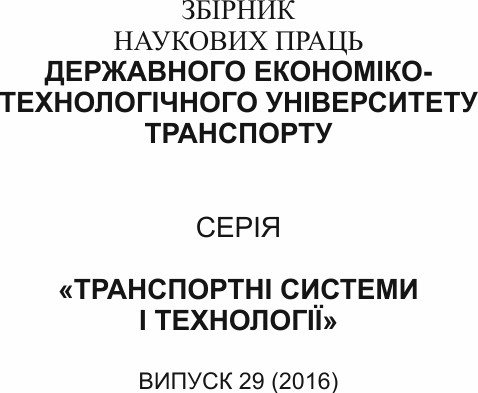THE DEVELOPMENT OF THE BASIC ELEMENTS FOR BUILDING A FREIGHT CAR RELIABILITY STUDY SYSTEM
Keywords:
system reliability study, failures, freight carsAbstract
The paper developed basic elements for the construction of the system reliability study of freight cars, including database and knowledge. At the same time it offered a block diagram of the system of freight cars and the reliability of the study described an algorithm for obtaining the knowledge of statistical data on failures of freight cars associated with the construction of models for various proximity, both observable categorical characteristics or represented by simple associative rules. For the construction of freight cars reliability study of the system involved fuzzy logic. The system of freight cars reliability studies based on knowledge of the communication fault indication and fault itself corresponding freight cars, which are formed by specialists repair and maintenance depots to be used the final confidence index at a given hypothesis a priori probabilities justice hypotheses with certain characteristics of freight cars fault. Freight car reliability study of the system contains a database of failures of freight cars and the knowledge base of refusals (hypotheses) or specific evidence (symptoms, causes) the possible occurrence of failures and their consequences (corresponding to the degree of severity). Database failures freight cars will serve the working memory system reliability study of freight cars for storing various input, output, and intermediate statistical data on failures that will be needed to solve the problem to ensure the appropriate level of design, technological and operational reliability of the freight cars. When the facts of new information updated, should be established working memory elements for each fact in the form of cortege are of fixed length. Group variable (failures and certificates), which are connected to each other, it is more convenient to store together in a cortege. The rows database table Bounce is a cortege of fixed length, content of which is carried out to establish the existence of failures of the freight cars according to the type and model that is followed by the establishment of the link between evidence (symptom) and failure (hypothesis) at a certain mileage of the freight cars.
References
1. Myamlin, S. V., Baranovskiy, D. M. (2014). The modeling of economic efficiency of products car-riagebuilding plant in conditions of dynamic pricing. Zbіrnik naukovix prac Dnіpropetrovskogo nacіonalnogo unіversitetu іm. ak. V. Lazaryana «Problemi ekonomіki transportu» [Proceedings of Dnipropetrovsk National University. Ac. V. Lazaryan «Problems of Transport Economy»]. 2014, № 7, pp. 61-66.
2. Fomin, O.V. Koncepcіja іdeal'nih kuzovіv napіvvagonіv [The concept of ideal bodies gondola] [Text] / O.V. Fomin // Journal of East Ukrainian National University named after Vladimir Dal, a scientific journal. − Lugansk: EUNU. Dal, 2013. − № 4 (193). − S. 267-271.
3. Fomin, O.V. Pіdvishhennja stupenja іdeal'nostі vantazhnih vagonіv ta prognozuvannja stadіj їh evoljucії [Increased ideal freight cars and forecasting stages of their evolution] [Text] / O.V Fomin // Scientific Bulletin of National Mining University. − Dnepropetrovsk: NSU, 2015. − № 3. − P. 68-76 − Access: http://nvngu.in.ua/index.php/uk/golovna/1049-ukrcat/arkhiv-zhurnalu/2015/zmist-3-2015/geotekhnichna-igirnicha- mekhanika-mashinobuduvannya/2975-pidvishchennya-stupenya-idealnosti-vantazhnikh-vagoniv-taprognozuvannya- stadij-jikh-evolyutsiji.
4. Fomin, O.V. Modern requirements to carrying systems of railway general-purpose gondola cars/ О.V. Fomin / Scientific and technical journal «Metallurgical and Mining Industry». 2014, No. 5 – P.31-43.
5. Prediction methodology of durability of locomotives diesel engines / L.P. Lingaitis, S. Mjamlin, D. Baranovsky, V. Jastremskas // Eksploatacja i Niezawodnosc − Maintenance and Reliability. 2012, Vol. 14, № 2. pp. 154-159.
6. Experimental Investigations on Operational Reliability of Diesel Locomotyves Engines / L.P. Lingaitis, S. Mjamlin, D. Baranovsky, V. Jastremskas // Eksploatacja i Niezawodnosc − Maintenance and Reliability. 2012, № 1, pp. 5-10.
7. Baranovskij D. M. Samoorganіzacіya struktur v procesі disipacії [Self-organizing structures in the process of dissipation]. Vostochno-Evropejskij zhurnal peredovyh tekhnologij [Eastern-European Journal of Enterprise Technologies]. 2009, № 8 (39), pp. 28-30.
8. Dzharratano Dzh., Rajli G. Ekspertnye sistemy. Principy razrabotki i programmirovanie [Expert systems. Principles of design and programming]. Moscow, Vil'yams, 2007. 1152 p.
9. Dzhekson P. Vvedenie v ehkspertnye sistemy [Introduction to Expert Systems]. Moscow, Izd. Dom «Vil'yams», 2001. 984 p.
10. Saati T. Matematicheskie modeli konfliktnyh situacij [Mathematical models of conflict situations]. Moscow, Sovetskoe radio, 1977. 189 p.
11. Averin A.N. Nechetkie mnozhestva v modelyah upravleniya iskusstvennogo intellekta [Fuzzy sets in management models of artificial intelligence]. Moscow, Nauka, 1986. 305 p.
12. Kofman A., Aluha X. Hil. Vvedenie teorii nechetkih mnozhestv: upravlenie predpriyatiem [Introduction to the theory of fuzzy sets: Enterprise Management]. Minsk, Vysshaya shkola, 1992. 223 p.
13. Betti, G., Cheli B. and Cambini R. A statistical model for the dynamics between two fuzzy states: theory and an application to poverty analysis, Metron, 2004, 62, pp. 391-411.
14. Cerioli A., Zani S. «A Fuzzy Approach to the Measurement of Poverty», in Dagum C. and Zenga M. (eds.), Income and Wealth Distribution, Inequality and Poverty, Springer Verlag, Berlin, 1990, pp. 272-284.
15. Cheli B., Betti G. Totally Fuzzy and Relative Measures of Poverty Dynamics in an Italian Pseudo Panel. 1985-1994. Metron 57(1-2), 1999, pp.83-104.
16. Cheli B., Ghellini G., Lemmi A., Pannuzi N. «Measuring Poverty in the Countries in Transition via TFR Method: the Case of Poland in 1990-1991», Statistics in Transition, 1(5), 1994, pp. 585- 636.
17. Cheli B., Lemmi A. A ‘Totally’ Fuzzy and Relative Approach to the Multidimensional Analysis of Poverty, Economic Notes, 24, 1995, pp. 115-134.
18. Chen S. and Hwang C. Fuzzy Multiple Decision Making, Springer-Verlag, Berlin, 1992.
19. Muradian L. Building models of freight cars refusals involving Bayesian approach // EUREKA: Physics and Engineering. – 2016. – №1. – С. 54–60.
20. Muradian L. A. Pobudova sistemi doslіdzhennya nadіjnostі vantazhnih vagonіv [Construction of system reliability study wagons]. Elektromagnіtna sumіsnіst' ta bezpeka na zalіznichnomu transportі [Electromagnetic compatibility and safety in railway transport], 2015, № 10, pp. 90-95.
Література:
1. Myamlin S.V., Baranovskiy D.M. The modeling of economic efficiency of products carriage-building plant in conditions of dynamic pricing. Збірник наукових праць Дніпропетровського національного університету ім. ак. В. Лазаряна «Проблеми економіки транспорту». – 2014. № 7. – С. 61-66.
2. Фомін О.В. Концепція ідеальних кузовів напіввагонів / О.В. Фомін // Вісник Східноукраїнського національного університету імені Володимира Даля: науковий журнал. – Луганськ: СНУ ім. В. Даля, 2013. – № 4(193). – С. 267–271.
3. Фомін, О.В. Підвищення ступеня ідеальності вантажних вагонів та прогнозування стадій їх еволюції / О.В. Фомін // Науковий вісник Національного гірничого університету. – Дніпропетровськ: НГУ, 2015. – №3. – С.68-76
4. Fomin, O. Modern requirements to carrying systems of railway general-purpose gondola cars/ О.V. Fomin / Scientific and technical journal «Metallurgical and Mining Industry». 2014, No. 5 – P.31-43.
5. Prediction methodology of durability of locomotives diesel engines / L.P. Lingaitis, S. Mjamlin, D. Baranovsky, V. Jastremskas // Eksploatacja i Niezawodnosc − Maintenance and Reliability. − 2012. − Vol. 14, № 2. − P. 154-159.
6. Experimental Investigations on Operational Reliability of Diesel Locomotyves Engines / L.P. Lingaitis, S. Mjamlin, D. Baranovsky, V. Jastremskas // Eksploatacja i Niezawodnosc − Maintenance and Reliability. − 2012. − № 1. − P. 5-10.
7. Барановський Д. М. Самоорганізація структур в процесі дисипації // Восточно-Европейский журнал передовых технологий. –2009. – № 8 (39). – С. 28–30.
8. Джарратано Дж., Райли Г. Экспертные системы. Принципы разработки и программирование. – М.: Вильямс, 2007. – 1152 с.
9. Джексон П. Введение в экспертные системы. – М.: Изд. дом «Вильямс», 2001. – 984 с.
10. Саати Т. Математические модели конфликтных ситуаций. – М.: Советское радио, 1977. – 189 с.
11. Аверин А.Н. Нечеткие множества в моделях управления искусственного интеллекта / Под ред. Д.А. Поспелова. – М.: Наука, 1986. – 305 с.
12. Кофман А., Алуха X. Хил. Введение теории нечетких множеств: управление предприятием. – Минск: Высшая школа, 1992. – 223 с.
13. Betti, G., Cheli B. and Cambini R. A statistical model for the dynamics between two fuzzy states: theory and an application to poverty analysis, Metron, 2004, 62, pp. 391-411.
14. Cerioli A., Zani S. «A Fuzzy Approach to the Measurement of Poverty», in Dagum C. and Zenga M. (eds.), Income and Wealth Distribution, Inequality and Poverty, Springer Verlag, Berlin, 1990, pp. 272-284.
15. Cheli B., Betti G. Totally Fuzzy and Relative Measures of Poverty Dynamics in an Italian Pseudo Panel. 1985-1994. Metron 57(1-2), 1999, pp.83-104.
16. Cheli B., Ghellini G., Lemmi A., Pannuzi N. «Measuring Poverty in the Countries in Transition via TFR Method: the Case of Poland in 1990-1991», Statistics in Transition, 1(5), 1994, pp. 585- 636.
17. Cheli B., Lemmi A. A ‘Totally’ Fuzzy and Relative Approach to the Multidimensional Analysis of Poverty, Economic Notes, 24, 1995, pp. 115-134.
18. Chen S. and Hwang C. Fuzzy Multiple Decision Making, Springer-Verlag, Berlin, 1992.
19. Muradian L. Building models of freight cars refusals involving Bayesian approach // EUREKA: Physics and Engineering. – 2016. – №1. – С. 54–60.
20. Мурадян Л.А. Побудова системи дослідження надійності вантажних вагонів // Електромагнітна су- місність та безпека на залізничному транспорті. – 2015. – № 10. – С. 90-95.
Downloads
Published
How to Cite
Issue
Section
License
Copyright: This is an open-access article distributed under the terms of the Creative Commons Attribution License, which permits unrestricted use, distribution, and reproduction in any medium, provided the original author and source are credited.














